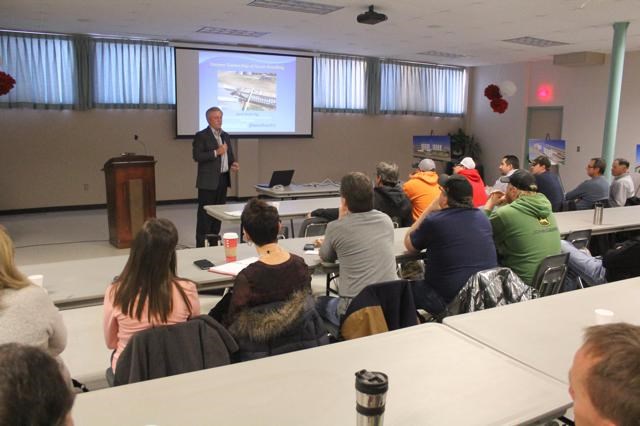By Greg Nikkel
A grassroots venture, Comtrax Logistics Solutions, is seeking to build a $75-million commodities hub on the Soo Line railway, at a location to be determined somewhere between Milestone and Midale, with the goal set to raise about $30 million from producers if they would like to see the project proceed to reality.
Members of the organizing committee for Comtrax held an information meeting in Weyburn on Friday morning at McKenna Hall, the third of 11 such meetings scheduled around southeast Saskatchewan, with a strong turnout from local producers to hear the proposal explained and to ask questions.
Committee member Mark Bratrud said the group thinks that $30 million is achievable, on the basis that producers could commit the equivalent of one bushel per acre, with the southeast comprised of 680,000 acres, spread over five years.
“For today’s farm sizes, that’s 150 producers on average, so we think it’s achievable,” said Bratrud, noting the balance of $45 million could come from the commercial partners they hope to line up to use the hub to gather and ship their commodities, including grain, crude oil, aggregates and fertilizer, and the sale of condos for these commodities. The group ideally would like to see involvement by 2-300 farmers from the southeast region.
The meeting was opened with agricultural commentator Kevin Hursh, who gave a brief history about farmer ownership of facilities in Saskatchewan, including the former Weyburn Inland Terminal, which was the first farmer-owned terminal on the prairies.
He noted that in the Inland Terminal Association, there used to be 10 to 12 farmer-owned facilities as members, and now that number has dropped to five. Of those five, two are owned 50-50 by producers in a partnership with Viterra.
Bratrud noted that a group of producers in the southeast pooled their ideas and resources to come up with this proposal for Comtrax, and they are now trying to gauge what the level of support might exist for such a facility in the Weyburn region.
Explaining why they will want commercial partnerships in this venture, Bratrud said, “It would be difficult to go on our own. Most grain trusts do have some sort of commercial partners. The key here, is there interest from producers here? Commercial entities are watching to see what interest there is.”
Looking at the numbers in terms of production of commodities, within a 120-mile radius of Weyburn, an average of 6,730,628 tonnes a year was produced between 2011 and 2015, ranging from a low of 3.7 million tonnes in the flood year of 2011, to a high of 9.4 million tonnes in 2013.
The trend is that crops are getting bigger, with production increasing by 15 per cent over the last 15 years, noted Bratrud.
The group met with eight major grain companies last winter to pitch the concept of this hub, said Bratrud. “The interest was very positive, and the structure they found quite intriguing. … We need to focus on a group of companies that will bring diversity and access to technology.”
With access to the Soo Line, there is access across Canada and into the United States to ship commodities, as well as access to the highway system.
On the oil side of things, organizing committee member Dan Cugnet suggested that such a hub could be used for shipping of crude oil to take advantage of the differential in value by using rail to ship oil down into the United States. He also pointed out that in spite of noises С����Ƶ made to the contrary, the consumption of oil is going to keep increasing, not decreasing, and with oilsands projects continuing to be developed, the peak of production from that region may not come until about 2030.
“It’s worth noting nobody is saying we’re going to go backwards from that point,” he said.
With the light crude С����Ƶ produced in the Bakken, it could be blended with medium and heavy oils from Alberta at such a facility as this hub, and shipped by rail. Cugnet noted that a small company producing 2,000 barrels of oil per day could fill a unit train once a month to ship south by rail. He also noted that in spite of the price of oil currently, there is still drilling of oil wells going on in this region.
With the coming twinning of Highway 39, and with the ongoing needs of area RMs for gravel, there are also opportunities for aggregate to be moved to areas that need it most.
In looking for a viable location, it was noted the proposed layout of the facility will accommodate the “new normal” for trains, which is now to ship 134 rail cars, so the hub will be built to provide trans-loading options for various commodities. The goal is to be able to load a 134-car train in eight hours, and to unload at a rate of eight cars an hour, with a proposed capacity of 60,000 tonnes, with room to expand if it’s needed.
“If we get that support (from producers), it’s going to make the discussions with commercials that much easier, and we want to increase the working group,” said Bratrud, noting an office has now been opened in Weyburn with an administrator. If there is a suitable level of support received, and a location can be determined, then the organizing committee will come back with a formal proposal for a facility.
“We’re very optimistic. We wouldn’t be here today if we didn’t think there was a chance for this to go forward,” said Bratrud. “You want something that will be competitive immediately, and be different from your competition. It has to be done right, and that will cost money.”




